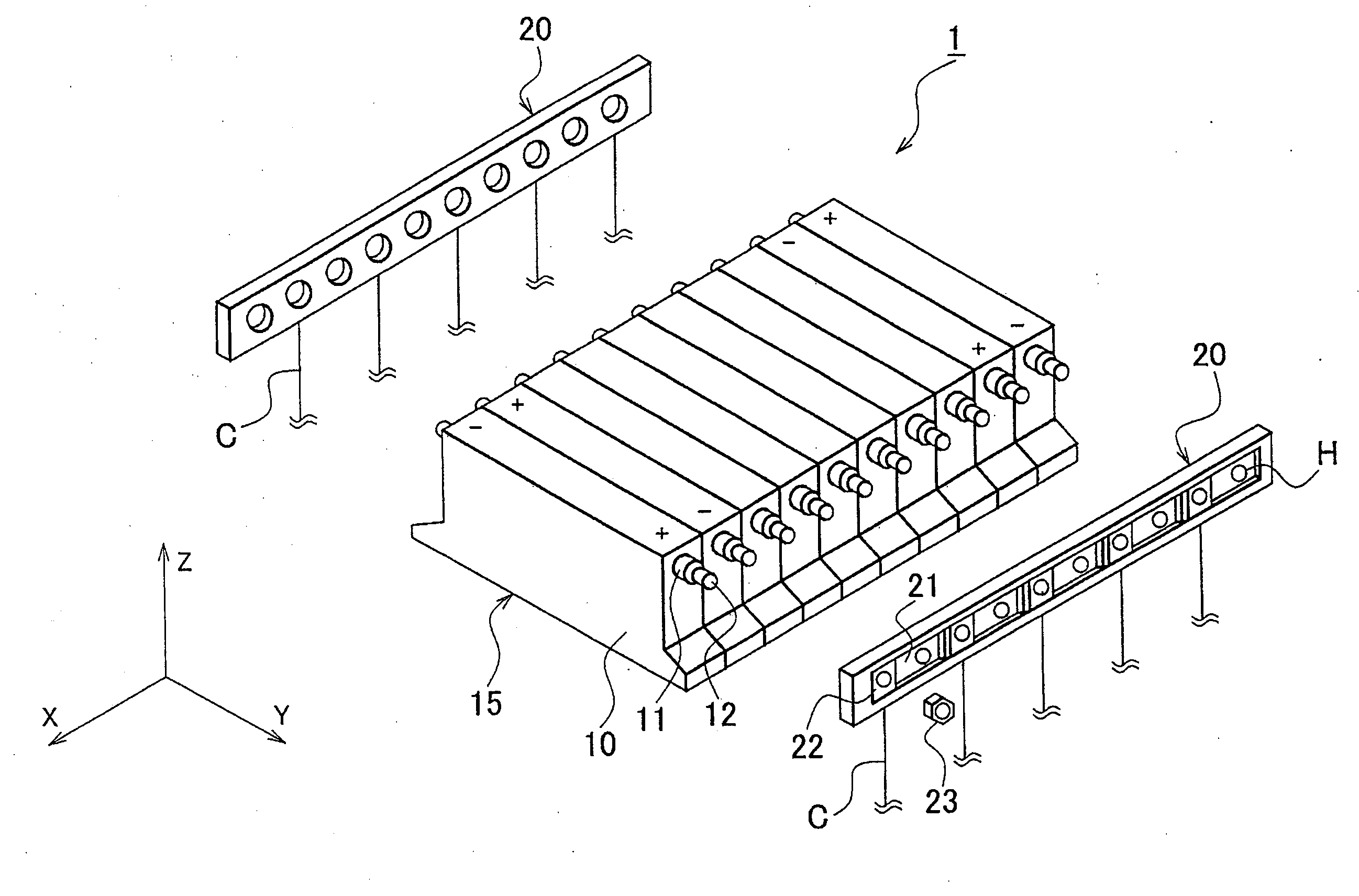Liquid leakage propagation restraining structure for electricity storage device and bus bar module
a technology of electricity storage device and restraining structure, which is applied in the direction of secondary cell servicing/maintenance, cell components, instruments, etc., can solve the problems of insufficient countermeasure against leakage of electrolytic solution, inability to carry out complete sealing, and difficulty in sealing against liquid leakag
- Summary
- Abstract
- Description
- Claims
- Application Information
AI Technical Summary
Benefits of technology
Problems solved by technology
Method used
Image
Examples
first embodiment
[0047]FIG. 1 is an exploded perspective view of an electricity storage device 1 to which the liquid leakage propagation restraining structure and the bus bar module of the invention are applied. The electricity storage device 1 includes a battery assembly (electricity storage assembly) 15 constructed of a plurality of electric cells 10, and bus bar modules 20 that electrically connect positive electrodes P (+) and negative electrodes N (−) of the electric cells 10 and that connects the electric cells of the entire battery assembly 15 in series.
[0048]The electricity storage device 1 is used as an electric power supply device mounted in a hybrid vehicle or an electric motor vehicle, such as a secondary battery that uses an alkaline electrolytic solution, including a nickel metal hydride storage battery (Ni-MH battery), a nickel cadmium storage battery (Ni—Cd battery), etc., a lithium ion secondary battery, an electric double layer capacitor, etc. Each electric cell 10 contains therein...
second embodiment
[0063]FIGS. 3A to 3C are diagrams illustrating the voltage detection terminal 22 in a second embodiment. FIG. 3A is a diagram illustrating the soldering connection of the voltage detection terminal 22. FIG. 3B is a perspective view of the voltage detection terminal 22. FIG. 3C is a cross-sectional view of an electric cable.
[0064]In the voltage detection terminal 22 in this embodiment, a crimp contact leg portion 221b (front leg) and another crimp contact leg portion 222b (rear leg) are entirely covered and sealed with solder (indicated by hatching in FIG. 3A), so that leakage of the electrolytic solution will not enter the core wire of the electric cable C. That is, generally in the related art, the electric cable C is connected by crimping to the crimp contact portion 22b via the crimp contact leg portions 221b and 222b, and the crimp contact leg portion 221b that is near the electric contact portion22a is soldered (i.e., only a portion to which exposed core wire C1 is electrically...
PUM
| Property | Measurement | Unit |
|---|---|---|
| voltage | aaaaa | aaaaa |
| length | aaaaa | aaaaa |
| diameter | aaaaa | aaaaa |
Abstract
Description
Claims
Application Information
 Login to View More
Login to View More - R&D
- Intellectual Property
- Life Sciences
- Materials
- Tech Scout
- Unparalleled Data Quality
- Higher Quality Content
- 60% Fewer Hallucinations
Browse by: Latest US Patents, China's latest patents, Technical Efficacy Thesaurus, Application Domain, Technology Topic, Popular Technical Reports.
© 2025 PatSnap. All rights reserved.Legal|Privacy policy|Modern Slavery Act Transparency Statement|Sitemap|About US| Contact US: help@patsnap.com



